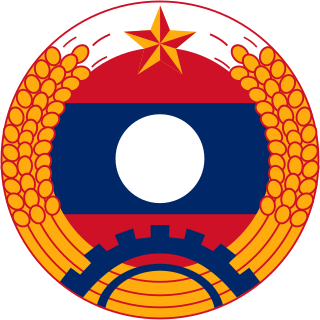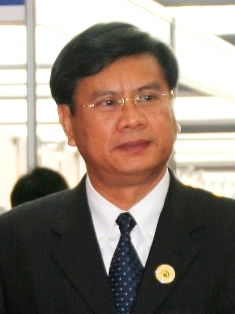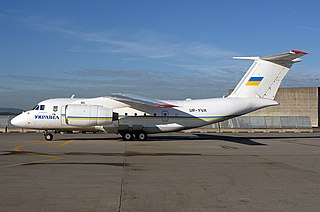Related Research Articles

Laos, officially the Lao People's Democratic Republic, is a socialist state and the only landlocked country in Southeast Asia. Located at the heart of the Indochinese peninsula, Laos is bordered by Myanmar and China to the northwest, Vietnam to the east, Cambodia to the southeast and Thailand to the west and southwest.

The politics of the Lao People's Democratic Republic takes place in the framework of a one-party socialist republic. The only legal political party is the Lao People's Revolutionary Party (LPRP). The de jure head of state is President Bounnhang Vorachith, who also is LPRP general secretary making him the de facto leader of Laos.

The Lao People's Armed Forces (LPAF) is the name of the armed forces of the Lao People's Democratic Republic and the institution of the Lao People's Revolutionary Party, who are charged with protecting the country.

The Kingdom of Laos was a constitutional monarchy that served Laos beginning with its independence on 9 November 1953. The monarchy survived until December 1975, when its last king, Savang Vatthana, surrendered the throne to the Pathet Lao, who abolished the monarchy in favor of a Marxist state called the Lao People's Democratic Republic, which has controlled Laos since.

The Pathet Lao was a communist political movement and organization in Laos, formed in the mid-20th century. The group was ultimately successful in assuming political power in 1975, after the Laotian Civil War. The Pathet Lao were always closely associated with Vietnamese communists. During the civil war, it was effectively organized, equipped and even led by the People's Army of Vietnam. They fought against the anti-communist forces in the Vietnam War. Eventually, the term became the generic name for Laotian communists.

The Laotian Civil War (1959–1975) was a civil war in Laos fought between the Communist Pathet Lao and the Royal Lao Government from 23 May 1959 to 2 December 1975. It is associated with the Cambodian Civil War and the Vietnam War, with both sides receiving heavy external support in a proxy war between the global Cold War superpowers. It is called the Secret War among the CIA Special Activities Division and Hmong veterans of the conflict.
General Khamtai Siphandone is a Laotian politician who was President of Laos from 24 February 1998, until 8 June 2006, when he was replaced by Choummaly Sayasone. He was a member of the Communist Party of Indochina in 1954 and a member of the Central Committee of the Lao People's Revolutionary Party in 1956.

The President of the Lao People's Democratic Republic is the head of state of Laos.

The situation of human rights in Laos has often been, and remains, a recognized cause for serious concern. Laos is one a handful of Marxist-Leninist governments and is ruled by a one-party communist government backed by the Lao People's Army in alliance with the Vietnam People's Army and the Socialist Republic of Vietnam in Hanoi.

The prime minister of the Lao People's Democratic Republic is the head of government of Laos. It is the highest office within the Central Government.

Bouasone Bouphavanh was Prime Minister of Laos from 2006 to 2010. He was officially appointed to the office by the National Assembly of Laos on June 8, 2006, during a major government reshuffle. He replaced Bounnhang Vorachith who became vice president. Bouasone had previously served as first deputy prime minister since October 3, 2003. Before that, he was third deputy prime minister and was president of the State Planning Committee. He ranks seventh in the Politburo. He was replaced as Prime Minister on 23 December 2010 by Thongsing Thammavong. Now, Bouasone Bouphavanh currently serves as head of the Lao Party Central Committee's Commission for Economic Development Strategy Research.

The Lao People's Revolutionary Youth Union (LPRYU) (Lao:ສູນກາງຊາວໜຸ່ມປະຊາຊົນປະຕິວັດລາວ) is a mass organisation in Laos, dedicated to mobilising young people throughout the country with a view to contributing to national development. It is the youth wing of the Lao People's Revolutionary Party, the Communist Party of Laos.

Laos – United States relations officially began when the United States opened a legation in Laos in 1950, when Laos was a semi-autonomous state within French Indochina. These relations were maintained after Lao independence in October 1953.

Thongsing Thammavong is a Laotian politician who was the Prime Minister of Laos from 2010 to 2016. He is a member of the Lao People's Revolutionary Party (LPRP) and has been a member of the LPRP Politburo since 1991. He currently serves in the National Assembly of Laos, representing Luang Prabang Province, and was the President of the National Assembly from 2006 to 2010. He became Prime Minister on 23 December 2010, and left office on 20 April 2016.

Vientiane is the capital and largest city of Laos, on the banks of the Mekong River near the border with Thailand. Vientiane became the capital in 1573 due to fears of a Burmese invasion but was later looted then razed to the ground in 1827 by the Siamese (Thai). Vientiane was the administrative capital during French rule and, due to economic growth in recent times, is now the economic center of Laos. The city had a population of 820,000 as at the 2015 Census.
Phankham Viphavanh is a Laotian politician, a member of Politburo and Executive Committee of the Lao People's Revolutionary Party. He is also the current Vice President of Laos, who was elected by the National Assembly of Laos in April 2016.
The Center for Public Policy Analysis (CPPA), or Centre for Public Policy Analysis, was established in Washington, D.C. in 1988 and describes itself as a non-profit, non-partisan, think tank and research organization. The CPPA is a non-governmental organization (NGO) focused on foreign policy, national security, human rights, refugee and international humanitarian issues.

On 17 May 2014, an Antonov An-74 transport aircraft of the Lao People's Liberation Army Air Force crashed while en route to Xiangkhouang Province, northern Laos, killing all but one of the 17 people on board. Among the victims were several Laotian politicians travelling to attend a ceremony celebrating the 55th anniversary of the second division of the Lao People's Army.
Laos has one of the most restrictive media environments in the world. In 2016, Reporters Without Borders ranked Laos 173 out of 179 on its annual Press Freedom Index, behind countries such as Cuba and Iran.
References
- ↑ "Laos Newspapers & News Media - ABYZ News Links".
- ↑ "60th anniversary of Lao Pasason's newspaper marked". KPL. August 12, 2010. Archived from the original on July 21, 2011. Retrieved September 4, 2010.
| This Laos-related article is a stub. You can help Wikipedia by expanding it. |